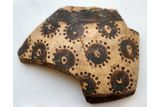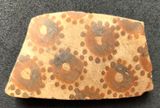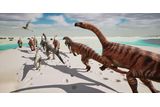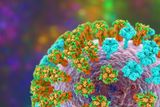FDA Approves Pill Version of Wegovy










Deal deepens contractor’s push into space-based sensing and optical communications.
The post CACI to buy space technology firm ARKA for $2.6 billion appeared first on SpaceNews.

Tory Bruno, the longtime chief executive of United Launch Alliance, is leaving the joint venture for another opportunity.
The post United Launch Alliance chief Tory Bruno resigns appeared first on SpaceNews.
A new measurement by CERN’s ATLAS Collaboration has strengthened evidence that the masses of fundamental particles originate through their interaction with the Higgs field. Building on earlier results from CERN’s CMS Collaboration, the observations suggest that muon–antimuon pairs (dimuons) can be created by the decay of Higgs bosons.
In the Standard Model of particle physics, the fermionic particles are organized into three different generations, broadly in terms of their masses. The first generation comprises the two lightest quarks (up and down), the lightest lepton (the electron) and the electron neutrino. The second includes the strange and charm quarks, the muon and its neutrino; and the third generation the bottom and top quarks, the tau and its neutrino. In terms of the charged fermions, the top quark is nearly 340,000 times heavier than the lightest – the electron.
All of the quarks and leptons have both right- and left-handed components, which relate to the direction of a particle’s spin relative to its direction of motion (right-handed if both directions are aligned; left-handed if they are anti-aligned).
Right- and left-handed particles are treated the same by the strong and electromagnetic forces, regardless of their generation in the Standard Model. The weak force, however, only acts on left-handed particles.
In the 1960s, Steven Weinberg uncovered a theoretical solution to this seemingly bizarre asymmetry. He proposed that the Higgs field acts as a bridge between each particle’s left- and right-handed components, in a way that respects the Standard Model’s underlying symmetry. This interaction causes the particle to constantly flip between its two components, creating a resistance to motion that can be perceived as mass.
However, this deepens the mystery. According to Weinberg’s theory, higher-mass particles must interact more strongly with this Higgs field – but in contrast, the strong and electromagnetic forces can only differentiate between these particles according to their charges (colour and electrical). The question is how does Higgs field can distinguish between particles in different generations if their charges are identical?
Key to solving this mystery will be to observe the decay products of Higgs bosons with different interaction strengths. For stronger interactions, corresponding to heavier generations, these decays should become far more likely.
In 2022, both the ATLAS and CMS collaborations did just this. Through proton–proton collision experiments at CERN’s Large Hadron Collider (LHC), the groups independently observed Higgs bosons decaying to tau–antitau pairs. This relatively common process occurred at the same rate as predicted by theory.
A year earlier, similar experiments by the CMS collaboration probed the second generation by observing muon–antimuon pairs from the decays of Higgs bosons. This rarer event occurs in just 1 in 5000 Higgs decays.
In their latest study, the ATLAS collaboration have now reproduced this CMS result independently. They collided protons at about 13 TeV and observed muon–antimuon pairs in the same range of energies predicted by theory.
Through the improvements they offer on the earlier CMS analysis, these new results bring dimuon observations to a statistical significance of 3.4σ. This is well below the 5σ standard required for the observation to be considered a discovery, so more work is needed.
The research could also provide guidance in the search for much rarer Higgs interactions that involve first-generation particles. This includes decay electron–positron pairs, originating from Higgs bosons which decay in just 1 in 200 million cases.
The research is described in Physical Review Letters.
The post Higgs decay to muon–antimuon pairs sheds light on the origin of mass appeared first on Physics World.

21 December 2025, Čakovec — Genesis Space Flight Laboratories launches its Microgravity Research Rideshare Program, making it easier and more affordable to conduct retrievable experiments in space. From now on, […]
The post Microgravity Research Rideshare Program Launched by Genesis, Experiments from €6K to and from SSO appeared first on SpaceNews.



The time is ripe to end the “Wolf Amendment,” a congressional bar inhibiting civil collaboration between the United States and China in space. The impetus for the law was noble — an attempt to challenge human rights conditions in China and prevent leaks of space-related technology — but in practice the ban harms our security […]
The post It’s time to unburden space cooperation with China appeared first on SpaceNews.

New Mexico — December 22, 2025 — Desert Works Propulsion (DWP) today announced the expansion of its domestic electric propulsion development and testing capabilities to address growing demand for advanced […]
The post Desert Works Propulsion expands U.S. ion propulsion capability through domestic manufacturing partnership and test capacity growth appeared first on SpaceNews.


Japan’s flagship H3 rocket suffered an issue with its second stage late Sunday resulting in the loss of the Michibiki 5 (QZS-5) navigation satellite.
The post Japan’s H3 suffers second-stage anomaly, QZS-5 satellite lost appeared first on SpaceNews.
Russia wants to revive a Soviet-era particle accelerator that has been abandoned since the 1990s. The Kurchatov Institute for High Energy Physics has allocated 176 million rubles ($25m) to assess the current condition of the unfinished 600 GeV Proton Accelerator and Storage Complex (UNK) in Protvino near Moscow. The move is part of plans to strengthen Russia’s technological sovereignty and its activity in high-energy physics.
Although work on the UNK was officially halted in the 1990s, construction only ceased in 2013. At that time, a 21 km tunnel had been built at a depth of 60 m along with underground experimental hall lighting and ventilation systems.
In February 2025, physicist Mikhail Kovalchuk, president of the Kurchatov Institute National Research Center, noted in Russia’s Kommersant newspaper that enormous intellectual and material resources had been invested in the UNK’s design and development before it was cancelled.
According to Kovalchuk, Western sanctions provided an additional impetus to restore the project, as scientists that had previously worked in CERN projects could no longer do so.
“By participating in [CERN] projects, we not only preserved our scientific potential and survived a difficult period, but also enriched ourselves intellectually and technologically,” added Kovalchuk. “Today we are self-sufficient.”
Anatoli Romaniouk, a Russian particle physicist who has worked at CERN since 1990, told Physics World that a revival of the UNK will at least maintain fundamental physics research in Russia.
“If this project is realized, then there is hope that it will be possible to at least somewhat slow down the scientific lag of Russian physics with global science,” says Romaniouk.
While official plans for the accelerator have not been disclosed, it is thought that the proton beam energy could be upgraded to reach 3 TeV. Romaniouk says it is also unclear what kind of science will be done with the accelerator, which will depend on what ideas come forward.
Yet some Russian scientists say that it could be used to produce neutrinos. This would involve putting a neutrino detector nearby to characterize the beam before it is sent some 4000 km towards Lake Baikal where a neutrino detector – the Baikal Deep Underwater Neutrino Telescope – is already installed 1 km underground.
“I think it’s possible to find an area of high-energy physics where the research with the help of this collider could be beneficial,” adds Romaniouk.
The post Russia plans to revive abandoned Soviet-era particle accelerator appeared first on Physics World.

New NASA Administrator Jared Isaacman said he wants NASA to move faster on programs such as Artemis but acknowledged he needs time to get up to speed on NASA’s activities.
The post Isaacman emphasizes accelerating NASA programs as he takes agency’s reins appeared first on SpaceNews.

Rocket Lab successfully launched a Japanese radar imaging satellite Dec. 21 in the final flight of a record-setting year for the company.
The post Rocket Lab wraps up record launch year appeared first on SpaceNews.


Blue Origin flew its final New Shepard suborbital mission of the year Dec. 20, carrying six people, including the first person who uses a wheelchair to travel to space.
The post Blue Origin flies first wheelchair user to space appeared first on SpaceNews.